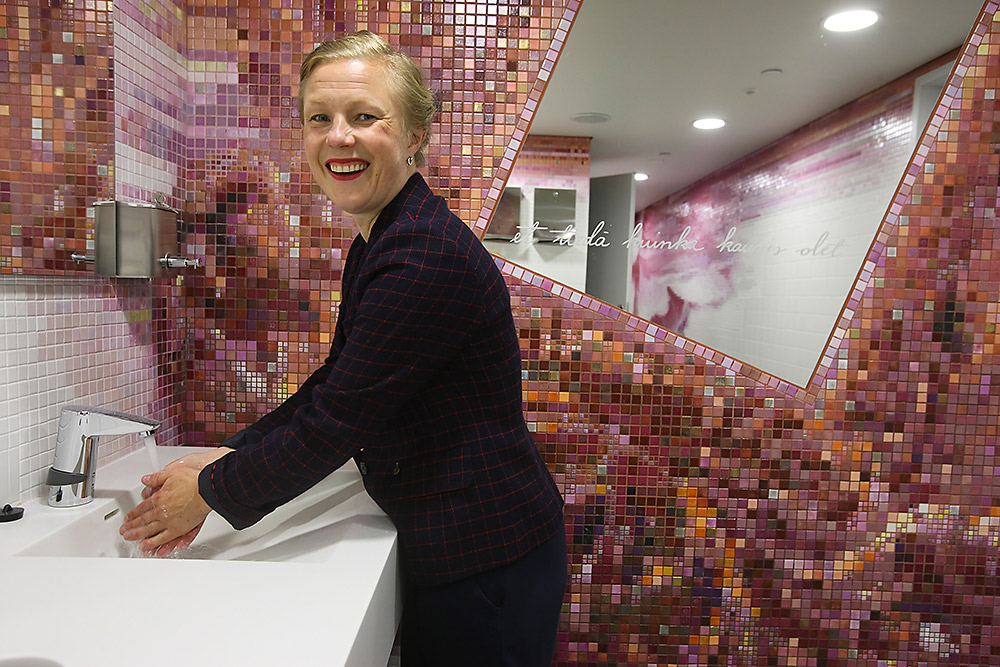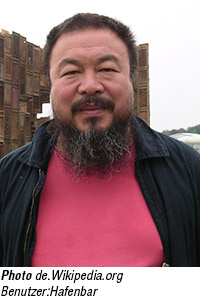
Art is present everywhere including the washrooms at Helsinki Art Museum. Marketing manager Saara Suojoki and a work by Finnish artist Tuula Lehtinen.
Photo Pertti Nisonen
HAM for short, Helsinki Art Museum reopens after extensive reconstruction in double the former space, with a new identity, and with a firm footing in the Helsinki art scene.
“There’s no other such space for art in the Nordic countries,” the director of Helsinki Art Museum HAM, Maija Tanninen-Mattila, exclaims enthusiastically as she introduces the art museum’s main galleries. The magnificent arching ceilings rise to 12 metres, allowing curatorial imagination to run wild with possibilities for exhibiting art.
The art museum is about to reopen after a reconstruction project that turned much of its home base, the Tennispalatsi recreational centre in downtown Helsinki, into a construction site for well over a year. The art museum has acquired the space of another museum, doubling its floor space.
Over the reconstruction period, HAM reworked its strategy and identity. The art museum envisions to become a space where people can leisurely hang out and interact socially.
“HAM is characterized by user-friendliness,” Tanninen-Mattila asserts. “We want to be part of the everyday experience of Helsinki residents.”
The new art museum is marked by openness, light, colours and inviting spaces. HAM forms a smooth continuation from the other tenants of Tennispalatsi, including the Finnkino movie theatres, a café and a restaurant, offering visitors similar social satisfaction. The overall objective of HAM is to lower or to abolish the barrier to come to an art museum.
“HAM wants to reach out to people who aren’t experienced art museum goers. We want to show them that art museums can be fun,” Tanninen-Mattila says.
“Our values are crystallized in ‘joy, courage, presence’ – three words that say it all.”
HAM’s new user experience has been created with Design Driven City designers and students of Aalto University. The art museum’s identity has been refined with a group of creative professionals.
Citizens’ own art collection
Tennispalatsi is home to HAM’s core exhibition operations. The art museum puts on display changing exhibitions that are not tied to any time period or geographical region, but the exhibition policy leans toward contemporary art and culture and international art. For example, the main opening exhibition consists of works by Chinese artist Ai Weiwei, one of the most influential contemporary artists of the day.
However, an important part of HAM’s mission is to bring the art museum’s own collection to its true owners – the citizens of Helsinki. One of HAM’s galleries, free to all visitors, exhibits only works from this collection in changing exhibitions.
“The collection includes many works never seen by the public before. We have many pleasant surprises in store for our visitors,” Tanninen-Mattila promises.
The majority of the art museum’s collection consists of Finnish art from the 19th and 20th centuries, but there are also some older works and international art. The collection’s many gems include notable works by the celebrated Finnish artists Helene Schjerfbeck (1862–1946) and Ellen Thesleff (1869–1954).
HAM’s collection is also visible at public places in Helsinki. The public artworks managed by HAM, altogether some 250 of them, include such famous works as the Sibelius Monument and the statue of Tsar Alexander II at the Senate Square. HAM plans to make the public artworks better known to citizens with new services.
“HAM is unique among Helsinki art museums in that it works with public art,” Tanninen-Mattila says. This dimension of HAM’s mission includes street art like graffiti and wall paintings. HAM even extends to the nearby Kamppi metro station, where the art museum exhibits Finnish street art.
Close to 4,000 artworks of the HAM collection are placed at Helsinki City offices and institutions.
Location beyond comparison
HAM is among a cluster of museums in Helsinki, many of them just hundreds of metres from each other. The cluster includes the Finnish National Gallery’s Ateneum Art Museum and Contemporary Art Museum Kiasma, and the private Amos Anderson Art Museum. “Helsinki has its own Museum Mile,” Tanninen-Mattila says.
HAM’s placement within the “Museum Mile” gives it a special advantage. Located in Tennispalatsi at the busy Kamppi Center – the new lively heart of Helsinki – HAM is in the midst of city life. Kamppi is a major transit hub, shopping complex and special events scene. The hugely popular Baana cycling route, built into a former railway corridor, runs right past HAM.
The location, coupled with the art museum’s new low-key identity, gives HAM good opportunities to achieve its goal of attracting new, non-traditional audiences.
Tanninen-Mattila points out, “We’re the one art museum in Helsinki that smells of popcorn!”
Helsinki Art Museum HAM
Tennispalatsi, Helsinki
Hours: Tuesday–Sunday 11–19, closed Monday
Admission: €10/8, free for visitors under 18
Grand reopening with Chinese and Finnish art
Helsinki Art Museum HAM welcomes visitors on Friday, 25 September 2015, in rebuilt and vastly bigger facilities than before. Admission is free on the opening day, and the opening weekend 25–27 September is filled with a special programme. Find the entire programme at www.hamhelsinki.fi.
 The main opening exhibition immerses visitors in the fascinating world of Chinese artist Ai Weiwei. The exhibition entitled Ai Weiwei @ Helsinki fills both of the art museum’s upper-floor galleries with installations, sculptures and photographs by this multi-faceted artist, also known as an architect and a political activist. The artworks reflect China’s past and present. Two of the works see their world debut in Helsinki.
The main opening exhibition immerses visitors in the fascinating world of Chinese artist Ai Weiwei. The exhibition entitled Ai Weiwei @ Helsinki fills both of the art museum’s upper-floor galleries with installations, sculptures and photographs by this multi-faceted artist, also known as an architect and a political activist. The artworks reflect China’s past and present. Two of the works see their world debut in Helsinki.
On the lower level, 100 years of Taidesalonki celebrates the centennial of Finland’s oldest art gallery, which was established by Finnish art dealer Leonard Bäcksbacka. On display are some of the most celebrated paintings of the Bäcksbacka Collection. More will be seen in subsequent exhibitions in a section of HAM dedicated to this collection, which forms the backbone of the art museum’s collection.
The galleries free to all visitors host The Aftermath, an exhibition by the Finnish artist duo IC-98, Patrik Söderlund and Visa Suonpää. The duo currently represents Finland at the Venice Biennale.
HAM Gallery opens with works by Finnish artist Reija Meriläinen in an exhibition entitled En Garde. HAM Gallery, also free to all visitors, is dedicated to new Finnish art and emerging artists in 7-week exhibitions.
What to look for at Helsinki Art Museum
The first gallery in Finland dedicated to Finnish artist Tove Jansson will open at Helsinki Art Museum in January 2016. The Tove Gallery will display works related to the life of Jansson, who is hailed as one of the leading visual artists of post-war Finland. The gallery will be the permanent home of two famous frescos by Jansson.
HAM Gallery will follow its opening exhibition with works by Tiina Raitanen in November 2015. More gems of the Bäcksbacka Collection will go on exhibit in January 2016. In April 2016, the art museum will put on exhibit works from the Heino Art Foundation’s celebrated collection of Finnish contemporary art.
HAM will follow the main opening exhibition Ai Weiwei @ Helsinki with more high-profile international art in October 2016, when the art museum’s 2016 season culminates in a retrospective of Japanese artist Yayoi Kusama. The exhibition includes many of the most significant works of this artist, who is acknowledged as one of the most important living artists to come out of Japan.
The darkening autumn evenings of 2016 will also be brightened by Scottish artist Douglas Gordon’s art installation based on Alfred Hitchcock’s film Psycho.
Helsinki Art Museum’s 2017 main exhibition will highlight Finnish modernism in an exhibition that celebrates 100 years of Finnish independence. Starting in February, the main galleries will host a reconstruction of the Finnish Pavilion designed by Finnish architect Alvar Aalto for the New York World’s Fair in 1939, as well as exhibiting Finnish modernism in international contexts.


